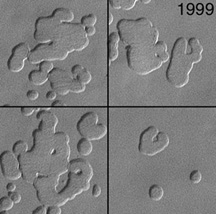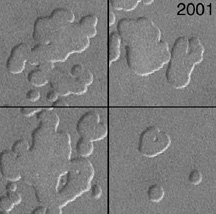

Compare each image on the left with their counterparts on the right. Small hills vanished and pit walls expanded between 1999 and 2001.The south polar pits form in frozen carbon dioxide, and the carbon dioxide is subliming away a little more each martian year. Sunlight illuminates each of the four different scenes from the upper left. Courtesy of NASA/JPL/Malin Space Science Systems.
Images taken by the spacecraft's camera system over a full martian year (687 Earth days) showed that pits in the planet's perennial southern polar ice cap were growing dramatically. The only material that might have sublimated into gas so quickly was carbon dioxide ice (dry ice), which was enlarging the pits by measurable amounts. This evidence confirmed a decades-old suspicion among researchers that the planet's surface ice was made of solid carbon dioxide instead of frozen water.
"This is prima-facie evidence of climate change," says Michael Malin of Malin Space Science Systems in San Diego, who, along with colleagues Michael Caplinger and Scott Davis, is principal investigator for the Global Surveyor's camera system. "The measurements have rather profound implications, and bring into question a number of our views about the short-term stability of the martian climate."
The pits are enlarging so quickly that the entire upper layer of the ice cap is likely to sublimate to gas within a martian decade or two. Carbon dioxide is a greenhouse gas, meaning that the pressure and temperature of the martian atmosphere may change dramatically over periods as short as a few hundred years.
If enough carbon dioxide is present in the south polar ice cap, it could potentially raise surface pressures enough to result in sufficiently warm temperatures for surface water to exist. Malin and Kenneth Edgett published a paper in the June 30, 2000, issue of Science describing evidence of gullies on the martian surface that may have been created by recent water flows.
Observations made with the Mars Orbiter Laser Altimeter (MOLA) were described in a separate study in the same issue of Science. A paper by David Smith, Maria Zuber and Gregory Neumann presented detailed measurements of the planet's topography and gravitational field suggesting significant changes in the martian atmosphere within the space of a single martian year.
Because it is also tilted on its rotational axis, Mars has seasons like Earth. As the surface gradually becomes darker during the martian autumn and winter, carbon dioxide gas "freezes out" of the atmosphere. Dense dry-ice snow accumulates at both poles, demarcated by a "frost line" that reaches the planet's mid-latitudes by winter. In spring and summer the process reverses.
The paper described how up to two meters of dry-ice snow accumulates in winter, mostly at latitudes above 80 degrees. The authors also reported a tiny change in the martian gravity field reflecting a global-scale mass redistribution. So much carbon dioxide is exchanged between atmosphere and surface -- as much as a third of the planet's carbon dioxide over a full martian year -- that the planet, which like Earth is slightly flattened, actually becomes rounder in winter.
"This is the first precise measurement of the global-scale cycling of the most abundant atmospheric gas on Mars," says Maria Zuber, the deputy principal investigator of the laser altimeter and a scientist at the Massachusetts Institute of Technology and NASA's Goddard Space Flight Center in Greenbelt, Md.. "Understanding the present carbon dioxide cycle is an essential step toward understanding past climates."
Malin adds that "Mars may help us decipher how natural climate systems on Mars and the Earth respond to rapid perturbations. The observations, if they do in fact lead to climate changes on Mars, also suggest that natural climate change may completely dominate human-induced climate change. Some people have suggested 'terraforming' Mars [altering its environment to make it more habitable], but our observations suggest that Mars is already experiencing a larger change than humans may ever be able to induce."
As evidence accumulates of significant, ongoing climate change on Earth, severe fluctuations in the martian climate strike closer to home. "There is quite a bit of evidence that suggests that severe episodic, or catastrophic phenomena are much more common in nature than we have thought," Malin says. "Certainly my research both on Earth and Mars strongly points to such processes as being most crucial in shaping the landscape."
Julian Smith
Geotimes contributing writer

